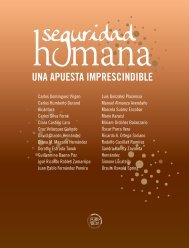Researching-the-Urban-Dilemma-Baseline-study
Researching-the-Urban-Dilemma-Baseline-study
Researching-the-Urban-Dilemma-Baseline-study
Create successful ePaper yourself
Turn your PDF publications into a flip-book with our unique Google optimized e-Paper software.
<strong>the</strong>mselves, giving rise to a Manichean landscape of “safe” gated communities and “violent”<br />
slums. 281 According to Gotz and Simone (2009), in some informal settings defined by volatility and<br />
unpredictability and control over confined spaces, tensions over unclaimed spaces can lead to <strong>the</strong> staging of<br />
exaggerated and often violent claims of belonging. 282 However, city disorder need not imply that urban spaces<br />
are unable to cope with such challenges and ultimately transform.<br />
On <strong>the</strong> contrary, <strong>the</strong> “resilience” of cities is a crucial feature that is often overlooked, and one from which<br />
important lessons can be drawn. 283 The concept of resilience can be defined as an ongoing process of<br />
adaptation/coping of territorially bounded units including <strong>the</strong> city’s formal as well as informal social, political,<br />
and economic institutions and its members and affiliates to exogenous and endogenous stress. 284 Indeed,<br />
proponents of <strong>the</strong> public health approach note how “protective factors” – characteristics of an individual and<br />
his/her environment that streng<strong>the</strong>n <strong>the</strong> capacity to confront stresses without recourse to violence – play a<br />
role in facilitating healing and decreasing <strong>the</strong> propensity of violence behavior. There is, for example,<br />
considerable evidence that a feeling of social connection is an important protective factor against violent<br />
behavior. 285<br />
While still a comparatively nascent area of <strong>study</strong>, <strong>the</strong>re is a growing body of work examining <strong>the</strong> critical place<br />
of protective factors in enhancing resilience and resistance to urban violence. Drawing largely on <strong>the</strong><br />
ecological model noted above, protective factors tend to be aggregated at multiple levels. Moreover, it is<br />
often <strong>the</strong> accumulation of such factors that are said to enhance <strong>the</strong> safety and security of urban residents.<br />
Examinations include “social connections” in <strong>the</strong> family at an early age – including <strong>the</strong> reduction of child<br />
exposure to violence but also <strong>the</strong>ir exposure to positive family role models. O<strong>the</strong>r social connections that are<br />
considered protective include peer groups as well as proactive community associations and schools and <strong>the</strong>ir<br />
authorities. Sociologists have also highlighted <strong>the</strong> role of community networks and productive employment<br />
opportunities as “protective.” 286<br />
281 See Lemanski (2012, 2007).<br />
282 Credit to Colin Marx for pointing out this argument. Interview, December 2012.<br />
283 See Muggah and Jutersonke (2012). See also URCV (www.urbanresilience.org) for a review of literature on how formal and informal<br />
institutions in cities adapt and cope with situations of chronic and acute violence.<br />
284 The URCV project´s approach to assessing resilience builds on <strong>the</strong> notions of (i) metabolic flows that sustain urban functions; (ii)<br />
governance networks and adaptive capacities of societies to meet urban challenges; and (iii) <strong>the</strong> social dynamics of citizens in relation<br />
(and response) to changes in <strong>the</strong>ir built environment. Ibid.<br />
285 See, for example, WHO (2002) and Gabriel et al (1996).<br />
286 See World Bank (2010).<br />
52




